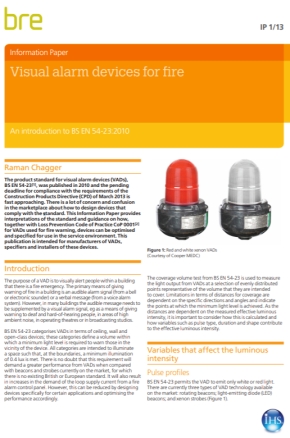Visual alarm devices for fire: An introduction and guide to BS EN 54-23
BRE (Building Research Establishment) is an independent, research-based consultancy, testing and training organisation, operating in the built environment and associated industries.
On 28 February 2012, BRE published Visual alarm devices for fire: An introduction and guide to BS EN 54-23.
The purpose of a visual alarm device (VAD) is to visually alert people within a building that there is a fire emergency. The primary means of giving warning of fire in a building is an audible signal (from a bell or electronic sounder) or a verbal message (from a voice alarm system). However, in many buildings the audible message needs to be supplemented by a visual alarm signal, eg as a means of giving warning to deaf and hard-of-hearing people, in areas of high ambient noise, in operating theatres or in broadcasting studios.
The product standard for VADs, BS EN 54-23, was published in 2010 and the deadline for compliance with the requirements of the Construction Products Directive (CPD) was March 2013. This Information Paper provides interpretations of the standard and guidance on how, together with Loss Prevention Code of Practice CoP 0001 for VADs used for fire warning, devices can be optimised and specified for use in the service environment.
This 12-page publication is intended for manufacturers of VADs, specifiers and installers. Its contents are:
- Introduction.
- Variables that affect the luminous intensity.
- The coverage volume test.
- Testing and approvals for VADs.
- Codes of practice for VADs.
- Conclusions.
- References.
Ref https://www.brebookshop.com/details.jsp?id=327102
[edit] Related articles on Designing Buildings Wiki
- BRE articles on Designing Buildings Wiki.
- BRE Buzz articles on Designing Buildings Wiki.
- BRE Buzz.
- BREEAM.
- Building Research Establishment.
- Visual alarm devices - their effectiveness in warning of fire.
- Automatic fire detection and alarm systems, an introductory guide to components and systems BR 510.
- Evacuating vulnerable and dependent people from buildings in an emergency FB 52.
- Fire detection and alarm system.
- Fire detector.
- Fire.
- Heat alarm.
- Ionisation smoke alarms.
- Optical smoke alarm.
- Personal protection watermist systems in the homes of vulnerable people.
- Smoke detector.
- The causes of false fire alarms in buildings.
- Understanding the factors affecting flashover of a fire in modern buildings.
Featured articles and news
The benefits of engaging with insulation manufacturers
When considering ground floor constructions.
Lighting Industry endorses Blueprint for Electrification
The Lighting Industry Association fully supports the ECA Blueprint as a timely, urgent call to action.
BSRIA Sentinel Clerk of Works Training Case Study
Strengthening expertise to enhance service delivery with integrated cutting-edge industry knowledge.
Impact report from the Supply Chain Sustainability School
Free sustainability skills, training and support delivered to thousands of UK companies to help cut carbon.
The Building Safety Forum at the Installershow 2025
With speakers confirmed for 24 June as part of Building Safety Week.
The UK’s largest air pollution campaign.
Future Homes Standard, now includes solar, but what else?
Will the new standard, due to in the Autumn, go far enough in terms of performance ?
BSRIA Briefing: Cleaner Air, Better tomorrow
A look back at issues relating to inside and outside air quality, discussed during the BSRIA briefing in 2023.
Restoring Abbotsford's hothouse
Bringing the writer Walter Scott's garden to life.
Reflections on the spending review with CIAT.
Retired firefighter cycles world to raise Grenfell funds
Leaving on 14 June 2025 Stephen will raise money for youth and schools through the Grenfell Foundation.
Key points for construction at a glance with industry reactions.
Functionality, visibility and sustainability
The simpler approach to specification.
Architects, architecture, buildings, and inspiration in film
The close ties between makers and the movies, with our long list of suggested viewing.
SELECT three-point plan for action issued to MSPs
Call for Scottish regulation, green skills and recognition of electrotechnical industry as part of a manifesto for Scottish Parliamentary elections.
UCEM becomes the University of the Built Environment
Major milestone in its 106-year history, follows recent merger with London School of Architecture (LSE).
Professional practical experience for Architects in training
The long process to transform the nature of education and professional practical experience in the Architecture profession following recent reports.
























